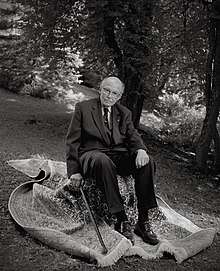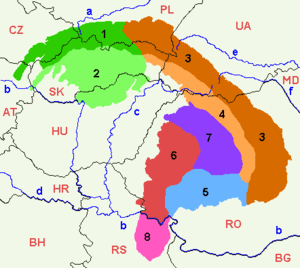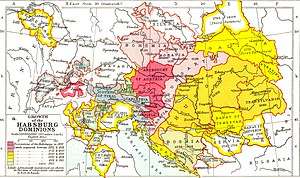Central Europe
Central Europe is the region comprising the central part of Europe. Central Europe occupies continuous territories that are otherwise sometimes considered parts of Western Europe, Southern Europe, and Eastern Europe.[3][4][5] The concept of Central Europe is based on a common historical, social, and cultural identity.[lower-alpha 1]
.svg.png)

Central Europe is going through a "strategic awakening",[16] with initiatives such as the Central European Initiative (CEI), Centrope, and the Visegrád Four Group. While the region's economies shows considerable disparities of income,[17] all the Central European countries are listed by the Human Development Index as very highly developed.[18]
Historical perspective
Middle Ages and early modern era
Elements of cultural unity for Northwestern, Southwestern and Central Europe were Catholicism and Latin. However Eastern Europe, which remained Eastern Orthodox, was the area of Graeco-Byzantine cultural influence; after the East-West Schism (1054), Eastern Europe developed cultural unity and resistance to the Catholic (and later also Protestant) Western world within the framework of Orthodox Church, Church Slavonic language and the Cyrillic alphabet.[19][20][21][22]
 Frankish Empire and its tributaries (AD 843–888)
Frankish Empire and its tributaries (AD 843–888)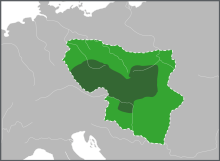 Certain and disputed borders of Great Moravia under Svatopluk I (AD 870–894)
Certain and disputed borders of Great Moravia under Svatopluk I (AD 870–894)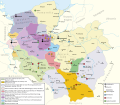 Kingdom of Poland in late 12th–13th centuries.
Kingdom of Poland in late 12th–13th centuries.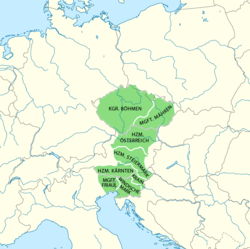 Bohemia in 1273
Bohemia in 1273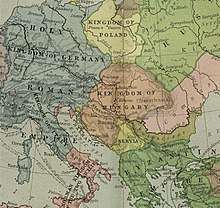 Kingdom of Hungary in 1190
Kingdom of Hungary in 1190 Stages of German eastern settlement, 700–1400 adapted from Walter Kuhn
Stages of German eastern settlement, 700–1400 adapted from Walter Kuhn Holy Roman Empire in 1600 superimposed on modern state borders
Holy Roman Empire in 1600 superimposed on modern state borders
According to Hungarian historian Jenő Szűcs, foundations of Central European history at the first millennium were in close connection with Western European development. He explained that between the 11th and 15th centuries not only Christianization and its cultural consequences were implemented, but well-defined social features emerged in Central Europe based on Western characteristics. The keyword of Western social development after millennium was the spread of liberties and autonomies in Western Europe. These phenomena appeared in the middle of the 13th century in Central European countries. There were self-governments of towns, counties and parliaments.[23]
In 1335, under the rule of the King Charles I of Hungary, the castle of Visegrád, the seat of the Hungarian monarchs was the scene of the royal summit of the Kings of Poland, Bohemia and Hungary.[24] They agreed to cooperate closely in the field of politics and commerce, inspiring their post-Cold War successors to launch a successful Central European initiative.[24]
In the Middle Ages, countries in Central Europe adopted Magdeburg rights.
Before World War I
Before 1870, the industrialization that had started to develop in Northwestern and Central Europe and the United States did not extend in any significant way to the rest of the world. Even in Eastern Europe, industrialization lagged far behind. Russia, for example, remained largely rural and agricultural, and its autocratic rulers kept the peasants in serfdom.[26] The concept of Central Europe was already known at the beginning of the 19th century,[27] but its real life began in the 20th century and immediately became an object of intensive interest. However, the very first concept mixed science, politics and economy – it was strictly connected with intensively growing German economy and its aspirations to dominate a part of European continent called Mitteleuropa. The German term denoting Central Europe was so fashionable that other languages started referring to it when indicating territories from Rhine to Vistula, or even Dnieper, and from the Baltic Sea to the Balkans.[28] An example of that-time vision of Central Europe may be seen in J. Partsch's book of 1903.[29]
On 21 January 1904, Mitteleuropäischer Wirtschaftsverein (Central European Economic Association) was established in Berlin with economic integration of Germany and Austria–Hungary (with eventual extension to Switzerland, Belgium and the Netherlands) as its main aim. Another time, the term Central Europe became connected to the German plans of political, economic and cultural domination. The "bible" of the concept was Friedrich Naumann's book Mitteleuropa[30] in which he called for an economic federation to be established after World War I. Naumann's idea was that the federation would have at its centre Germany and the Austro-Hungarian Empire but would also include all European nations outside the Triple Entente.[31] The concept failed after the German defeat in World War I and the dissolution of Austria-Hungary. The revival of the idea may be observed during the Hitler era.
Interwar period

According to Emmanuel de Martonne, in 1927 the Central European countries included: Austria, Czechoslovakia, Germany, Hungary, Poland, Romania and Switzerland. The author uses both Human and Physical Geographical features to define Central Europe, but he doesn't take into account the legal development, or the social, cultural, economic, infrastructural developments in these countries.[33]
The interwar period (1918–1939) brought a new geopolitical system, as well as economic and political problems, and the concept of Central Europe took on a different character. The centre of interest was moved to its eastern part – the countries that have (re)appeared on the map of Europe: Czechoslovakia, Hungary and Poland. Central Europe ceased to be the area of German aspiration to lead or dominate and became a territory of various integration movements aiming at resolving political, economic and national problems of "new" states, being a way to face German and Soviet pressures. However, the conflict of interests was too big and neither Little Entente nor Intermarium (Międzymorze) ideas succeeded.
The interwar period brought new elements to the concept of Central Europe. Before World War I, it embraced mainly German states (Germany, Austria), non-German territories being an area of intended German penetration and domination – German leadership position was to be the natural result of economic dominance.[27] After the war, the Eastern part of Central Europe was placed at the centre of the concept. At that time the scientists took an interest in the idea: the International Historical Congress in Brussels in 1923 was committed to Central Europe, and the 1933 Congress continued the discussions.[34]
Hungarian historian Magda Ádám wrote in her study Versailles System and Central Europe (2006): "Today we know that the bane of Central Europe was the Little Entente, military alliance of Czechoslovakia, Romania and Kingdom of Serbs, Croats and Slovenes (later Yugoslavia), created in 1921 not for Central Europe's cooperation nor to fight German expansion, but in a wrong perceived notion that a completely powerless Hungary must be kept down".[34]
The avant-garde movements of Central Europe were an essential part of modernism's evolution, reaching its peak throughout the continent during the 1920s. The Sourcebook of Central European avantgards (Los Angeles County Museum of Art) contains primary documents of the avant-gardes in Austria, Czechoslovakia, Germany, Hungary, and Poland from 1910 to 1930.[32] The manifestos and magazines of Western European radical art circles are well known to Western scholars and are being taught at primary universities of their kind in the western world.
Mitteleuropa
Mitteleuropa may refer to an historical concept, or to a contemporary German definition of Central Europe. As an historical concept, the German term Mitteleuropa (or alternatively its literal translation into English, Middle Europe[35]) is an ambiguous German concept.[35] It is sometimes used in English to refer to an area somewhat larger than most conceptions of 'Central Europe'; it refers to territories under Germanic cultural hegemony until World War I (encompassing Austria–Hungary and Germany in their pre-war formations but usually excluding the Baltic countries north of East Prussia). According to Fritz Fischer Mitteleuropa was a scheme in the era of the Reich of 1871–1918 by which the old imperial elites had allegedly sought to build a system of German economic, military and political domination from the northern seas to the Near East and from the Low Countries through the steppes of Russia to the Caucasus.[36] Later on, professor Fritz Epstein argued the threat of a Slavic "Drang nach Westen" (Western expansion) had been a major factor in the emergence of a Mitteleuropa ideology before the Reich of 1871 ever came into being.[37]
In Germany the connotation was also sometimes linked to the pre-war German provinces east of the Oder-Neisse line.
The term "Mitteleuropa" conjures up negative historical associations among some elderly people, although the Germans have not played an exclusively negative role in the region.[38] Most Central European Jews embraced the enlightened German humanistic culture of the 19th century.[39] German-speaking Jews from turn of the 20th century Vienna, Budapest and Prague became representatives of what many consider to be Central European culture at its best, though the Nazi version of "Mitteleuropa" destroyed this kind of culture instead.[40] However, the term "Mitteleuropa" is now widely used again in German education and media without negative meaning, especially since the end of communism. In fact, many people from the new states of Germany do not identify themselves as being part of Western Europe and therefore prefer the term "Mitteleuropa".
Central Europe during World War II
During World War II, Central Europe was largely occupied by Nazi Germany. Many areas were a battle area and were devastated. The mass murder of the Jews depopulated many of their centuries-old settlement areas or settled other people there and their culture was wiped out. Both Adolf Hitler and Joseph Stalin diametrically opposed the centuries-old Habsburg principles of "live and let live" with regard to ethnic groups, peoples, minorities, religions, cultures and languages and tried to assert their own ideologies and power interests in Central Europe. There were various Allied plans for state order in Central Europe for post-war. While Stalin tried to get as many states and his control as possible, Winston Churchill preferred a Central European Danube Confederation to counter these countries against Germany and Russia. There were also various resistance movements around Otto von Habsburg that pursued this goal. The group around the Austrian priest Heinrich Maier also planned in this direction, which also successfully helped the Allies to wage war by, among other things, forwarding production sites and plans for V-2 rockets, Tiger tanks and aircraft to the USA. There were various considerations to prevent German power in Europe after the war. As a result of the military situation at the end of the war, Stalin's plans prevailed and much of Central Europe came under Russian control.[41][42]
Central Europe behind the Iron Curtain

Following World War II, large parts of Europe that were culturally and historically Western became part of the Eastern bloc. Czech author Milan Kundera (emigrant to France) thus wrote in 1984 about the "Tragedy of Central Europe" in the New York Review of Books.[44] Consequently, the English term Central Europe was increasingly applied only to the westernmost former Warsaw Pact countries (East Germany, Poland, Czechoslovakia, Hungary) to specify them as communist states that were culturally tied to Western Europe.[45] This usage continued after the end of the Warsaw Pact when these countries started to undergo transition.
The post-World War II period brought blocking of research on Central Europe in the Eastern Bloc countries, as its every result proved the dissimilarity of Central Europe, which was inconsistent with the Stalinist doctrine. On the other hand, the topic became popular in Western Europe and the United States, much of the research being carried out by immigrants from Central Europe.[46] At the end of communism, publicists and historians in Central Europe, especially the anti-communist opposition, returned to their research.[47]
According to Karl A. Sinnhuber (Central Europe: Mitteleuropa: Europe Centrale: An Analysis of a Geographical Term)[43] most Central European states were unable to preserve their political independence and became Soviet Satellite Europe. Besides Austria, only the marginal European states of Finland and Yugoslavia preserved their political sovereignty to a certain degree, being left out of any military alliances in Europe.
Roles
According to American professor Ronald Tiersky, the 1991 summit held in Visegrád, Hungary and attended by the Polish, Hungarian and Czechoslovak presidents was hailed at the time as a major breakthrough in Central European cooperation, but the Visegrád Group became a vehicle for coordinating Central Europe's road to the European Union, while development of closer ties within the region languished.[48]
.png)
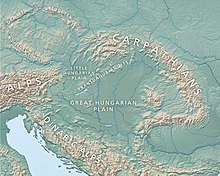
American professor Peter J. Katzenstein described Central Europe as a way station in a Europeanization process that marks the transformation process of the Visegrád Group countries in different, though comparable ways.[49] According to him, in Germany's contemporary public discourse "Central European identity" refers to the civilizational divide between Catholicism and Eastern Orthodoxy.[49] He says there's no precise, uncontestable way to decide whether the Baltic states, Serbia, Croatia, Slovenia, Romania, and Bulgaria are parts of Central Europe or not.[50]
Definitions

Rather than a physical entity, Central Europe is a concept of shared history which contrasts with that of the surrounding regions. The issue of how to name and define the Central European region is subject to debates. Very often, the definition depends on the nationality and historical perspective of its author.
Academic
The main proposed regional definitions, gathered by Polish historian Jerzy Kłoczowski, include:[51]
- West-Central and East-Central Europe – this conception, presented in 1950,[52] distinguishes two regions in Central Europe: German West-Centre, with imperial tradition of the Reich, and the East-Centre covered by variety of nations from Finland to Greece, placed between great empires of Scandinavia, Germany, Italy and the Soviet Union.
- Central Europe as the area of cultural heritage of the Polish–Lithuanian Commonwealth – Ukrainian, Belarusian and Lithuanian historians, in cooperation (since 1990) with Polish historians, insist on the importance of the concept.
- Central Europe as a region connected to the Western civilisation for a very long time, including countries such as the Polish–Lithuanian Commonwealth, Kingdom of Croatia, Holy Roman Empire, later German Empire and the Habsburg Monarchy, the Kingdom of Hungary and the Crown of Bohemia. Central Europe understood in this way borders on Russia and South-Eastern Europe, but the exact frontier of the region is difficult to determine.
- Central Europe as the area of cultural heritage of the Habsburg Empire (later Austria-Hungary) – a concept which is popular in regions along the Danube River: Austria, the Czech Republic and Slovakia, Slovenia, large parts of Croatia, Romania and Serbia, also smaller parts of Poland and Ukraine. In Hungary, the narrowing of Central Europe into former Habsburg lands is not popular.
- A concept underlining the links connecting Belarus, Moldova and Ukraine with Russia and treating the Russian Empire together with the whole Slavic Orthodox population as one entity – this position is taken by the Russian historiography.
- A concept putting the accent on links with the West, especially from the 19th century and the grand period of liberation and formation of Nation-states – this idea is represented by the South-Eastern states, which prefer the enlarged concept of the "East Centre" expressing their links with Western culture.
Former University of Vienna professor Lonnie R. Johnson points out criteria to distinguish Central Europe from Western, Eastern and Southeast Europe:[53]
- One criterion for defining Central Europe is the frontiers of medieval empires and kingdoms that largely correspond to the religious frontiers between the Catholic West and the Orthodox East.[54] The pagans of Central Europe were converted to Catholicism while in Southeastern and Eastern Europe they were brought into the fold of the Eastern Orthodox Church.[54]
- Multinational empires were a characteristic of Central Europe.[54] Hungary and Poland, small and medium-size states today, were empires during their early histories.[54] The historical Kingdom of Hungary was until 1918 three times larger than Hungary is today,[54] while Poland was the largest state in Europe in the 16th century.[54] Both these kingdoms housed a wide variety of different peoples.[54]
He also thinks that Central Europe is a dynamic historical concept, not a static spatial one. For example, Lithuania, a fair share of Belarus and western Ukraine are in Eastern Europe today, but 230 years ago they were in Polish–Lithuanian Commonwealth.[54]
Johnson's study on Central Europe received acclaim and positive reviews[55][56] in the scientific community. However, according to Romanian researcher Maria Bucur this very ambitious project suffers from the weaknesses imposed by its scope (almost 1600 years of history).[57]
Encyclopedias, gazetteers, dictionaries
The Columbia Encyclopedia defines Central Europe as: Germany, Switzerland, Liechtenstein, Austria, Poland, the Czech Republic, Slovakia, and Hungary.[58] The World Factbook[1] uses a similar definition and adds also Slovenia. Encarta Encyclopedia and Encyclopædia Britannica do not clearly define the region, but Encarta places the same countries into Central Europe in its individual articles on countries, adding Slovenia in "south central Europe".[59]
The German Encyclopaedia Meyers Grosses Taschenlexikon (Meyers Big Pocket Encyclopedia), 1999, defines Central Europe as the central part of Europe with no precise borders to the East and West. The term is mostly used to denominate the territory between the Schelde to Vistula and from the Danube to the Moravian Gate. Usually the countries considered to be Central European are Austria, Croatia, the Czech Republic, Germany, Hungary, Poland, Slovakia, Slovenia, Switzerland; in the broader sense Romania and Serbia too, occasionally also Belgium, the Netherlands, and Luxembourg.
According to Meyers Enzyklopädisches Lexikon,[60] Central Europe is a part of Europe composed of Austria, Belgium, Czechoslovakia, Germany, Hungary, Luxembourg, Netherlands, Poland, Romania and Switzerland, and northern marginal regions of Italy and Yugoslavia (northern states – Croatia, Serbia and Slovenia), as well as northeastern France.
The German Ständige Ausschuss für geographische Namen (Standing Committee on Geographical Names), which develops and recommends rules for the uniform use of geographical names, proposes two sets of boundaries. The first follows international borders of current countries. The second subdivides and includes some countries based on cultural criteria. In comparison to some other definitions, it is broader, including Luxembourg, Croatia, the Baltic states, and in the second sense, parts of Russia, Belarus, Ukraine, Romania, Serbia, Italy, and France.[2]
Geographical
There is no general agreement either on what geographic area constitutes Central Europe, nor on how to further subdivide it geographically.[61]
At times, the term "Central Europe" denotes a geographic definition as the Danube region in the heart of the continent, including the language and culture areas which are today included in the states of Croatia, the Czech Republic, Hungary, Poland, Serbia, Slovakia, Slovenia and usually also Austria and Germany, but never Russia and other countries of the former Soviet Union towards the Ural mountains.[62]
Governmental and standards organisations
The terminology EU11 countries refer the Central, Eastern and Baltic European member states which accessed in 2004 and after: in 2004 the Czech Republic, Estonia, Latvia, Lithuania, Hungary, Poland, Slovenia, and the Slovak Republic; in 2007 Bulgaria, Romania; and in 2013 Croatia.[63]
Map gallery

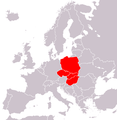 According to The Economist and Ronald Tiersky a strict definition of Central Europe means the Visegrád Group[48][64]
According to The Economist and Ronald Tiersky a strict definition of Central Europe means the Visegrád Group[48][64]- Map of Central Europe, according to Lonnie R. Johnson (2011)[65]Countries considered to be Central European only in the broader sense of the term.
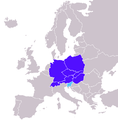 Central European countries in Encarta Encyclopedia (2009)[59]Central European countriesSlovenia in "south central Europe"
Central European countries in Encarta Encyclopedia (2009)[59]Central European countriesSlovenia in "south central Europe"- The Central European Countries according to Meyers Grosses Taschenlexikon (1999):Countries usually considered Central EuropeanCentral European countries in the broader sense of the termCountries occasionally considered to be Central European
- Middle Europe (Brockhaus Enzyklopädie, 1998)
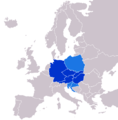 Central Europe according to Swansea University professors Robert Bideleux and Ian Jeffries (1998)[66]
Central Europe according to Swansea University professors Robert Bideleux and Ian Jeffries (1998)[66]- Central Europe, as defined by E. Schenk (1950)[67]
- Central Europe, according to Alice F. A. Mutton in Central Europe. A Regional and Human Geography (1961)
- Central Europe according to Meyers Enzyklopaedisches Lexikon (1980)
States
The comprehension of the concept of Central Europe is an ongoing source of controversy,[68] though the Visegrád Group constituents are almost always included as de facto C.E. countries.[64] Although views on which countries belong to Central Europe are vastly varied, according to many sources (see section Definitions) the region includes the states listed in the sections below.
Depending on context, Central European countries are sometimes grouped as Eastern or Western European countries, collectively or individually[69][70][71][72] but some place them in Eastern Europe instead:[69][70][71] for instance Austria can be referred to as Central European, as well as Eastern European[73] or Western European.[74]
Other countries and regions
Some sources also add neighbouring countries for historical reasons (the former Austro-Hungarian and German Empires, and modern Baltic states), or based on geographical and/or cultural reasons:
- Croatia[53][75][76][77][78] (alternatively placed in Southeast Europe)[79][80]
- Romania (Transylvania, along with Banat, Crișana, and Maramureș[81] as well as Bukovina[82])[83][84][85]
- Serbia (primarily Vojvodina and Northern Belgrade)[86][87][88][89][90][91]
- Slovenia[92] (alternatively placed in Southeast Europe)[93]
- Ukraine (Transcarpathia,[94] Galicia and Northern Bukovina[82])
The Baltic states, geographically in Northern Europe, have been considered part of Central Europe in the German tradition of the term, Mitteleuropa. Benelux countries are generally considered a part of Western Europe, rather than Central Europe. Nevertheless, they are occasionally mentioned in the Central European context due to cultural, historical and linguistic ties.
The following states or some of their regions may sometimes be included in Central Europe:
Geography
Geography defines Central Europe's natural borders with the neighbouring regions to the north across the Baltic Sea, namely Northern Europe (or Scandinavia), and to the south across the Alps, the Apennine peninsula (or Italy), and the Balkan peninsula[61] across the Soča-Krka-Sava-Danube line. The borders to Western Europe and Eastern Europe are geographically less defined, and for this reason the cultural and historical boundaries migrate more easily west–east than south–north. The Rhine river, which runs south–north through Western Germany, is an exception.
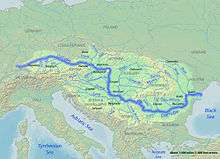
Southwards, the Pannonian Plain is bounded by the rivers Sava and Danube – and their respective floodplains.[96] The Pannonian Plain stretches over the following countries: Austria, Croatia, Hungary, Romania, Serbia, Slovakia and Slovenia, and touches borders of Bosnia and Herzegovina (Republika Srpska) and Ukraine ("peri- Pannonian states").
As southeastern division of the Eastern Alps,[97] the Dinaric Alps extend for 650 kilometres along the coast of the Adriatic Sea (northwest-southeast), from the Julian Alps in the northwest down to the Šar-Korab massif, north–south. According to the Freie Universität Berlin, this mountain chain is classified as South Central European.[98]
The Central European flora region stretches from Central France (the Massif Central) to Central Romania (Carpathians) and Southern Scandinavia.[99]
Demography
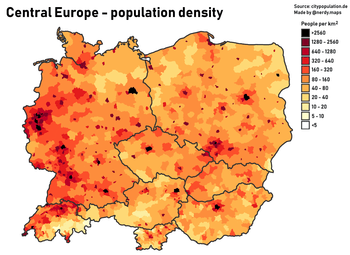
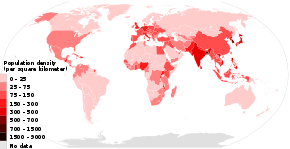
Central Europe is one of the continent's most populous regions. It includes countries of varied sizes, ranging from tiny Liechtenstein to Germany, the largest European country by population (that is entirely placed in Europe). Demographic figures for countries entirely located within notion of Central Europe ("the core countries") number around 165 million people, out of which around 82 million are residents of Germany.[100] Other populations include: Poland with around 38.5 million residents,[101] Czech Republic at 10.5 million,[102] Hungary at 10 million,[103] Austria with 8.8 million, Switzerland with 8.5 million,[104] Slovakia at 5.4 million,[105] and Liechtenstein at a bit less than 40,000.[106]
If the countries which are occasionally included in Central Europe were counted in, partially or in whole – Croatia (4.3 million),[107] Slovenia (2 million, 2014 estimate),[108] Romania (20 million), Lithuania (2.9 million), Latvia (2 million), Estonia (1.3 million), Serbia (7.1 million) [109] – it would contribute to the rise of between 25–35 million, depending on whether regional or integral approach was used.[110] If smaller, western and eastern historical parts of Central Europe would be included in the demographic corpus, further 20 million people of different nationalities would also be added in the overall count, it would surpass the 200 million people figure.
Economy
Currencies
Currently, the members of the Eurozone include Austria, Germany, Luxembourg, Slovakia, and Slovenia. Croatia, the Czech Republic, Hungary and Poland use their currencies (Croatian kuna, Czech koruna, Hungarian forint, Polish złoty), but are obliged to adopt the Euro. Switzerland uses its own currency – Swiss franc, Serbia too (Serbian dinar), as well as Romania (Romanian leu).
Human Development Index
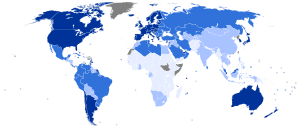
Very High | Low |
High | Data unavailable |
Medium |
In 2018, Switzerland topped the HDI list among Central European countries, also ranking #2 in the world. Serbia rounded out the list at #11 (67 world).
Globalisation
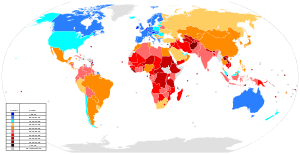
The index of globalization in Central European countries (2016 data):[111] Switzerland topped this list as well (#1 world).
Prosperity Index
Legatum Prosperity Index demonstrates an average and high level of prosperity in Central Europe (2018 data).[112] Switzerland topped the index (#4 world).
Corruption
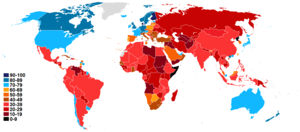
| 90–100 | 60–69 | 30–39 | 0–9 |
| 80–89 | 50–59 | 20–29 | No information |
| 70–79 | 40–49 | 10–19 |
Most countries in Central Europe tend to score above the average in the Corruption Perceptions Index (2018 data),[113] led by Switzerland, Germany, and Austria.
Infrastructure
Industrialisation occurred early in Central Europe. That caused construction of rail and other types of infrastructure.
Rail
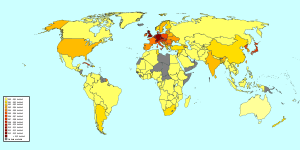
Central Europe contains the continent's earliest railway systems, whose greatest expansion was recorded in Austro-Hungarian and German territories between 1860-1870s.[114] By the mid-19th century Berlin, Vienna, and Buda/Pest were focal points for network lines connecting industrial areas of Saxony, Silesia, Bohemia, Moravia and Lower Austria with the Baltic (Kiel, Szczecin) and Adriatic (Rijeka, Trieste).[115] Rail infrastructure in Central Europe remains the densest in the world. Railway density, with total length of lines operated (km) per 1,000 km2, is the highest in the Czech Republic (198.6), Poland (121.0), Slovenia (108.0), Germany (105.5), Hungary (98.7), Serbia (87.3), Slovakia (73.9) and Croatia (72.5).[116][117] when compared with most of Europe and the rest of the world.[118][119]
River transport and canals
Before the first railroads appeared in the 1840s, river transport constituted the main means of communication and trade.[115] Earliest canals included Plauen Canal (1745), Finow Canal, and also Bega Canal (1710) which connected Timișoara to Novi Sad and Belgrade via Danube.[115] The most significant achievement in this regard was the facilitation of navigability on Danube from the Black sea to Ulm in the 19th century.
Branches
Compared to most of Europe, the economies of Austria, Croatia, the Czech Republic, Germany, Hungary, Poland, Slovakia, Slovenia and Switzerland tend to demonstrate high complexity. Industrialisation has reached Central Europe relatively early: Luxembourg and Germany by 1860, the Czech Republic, Poland, Slovakia and Switzerland by 1870, Austria, Croatia, Hungary, Liechtenstein, Romania, Serbia and Slovenia by 1880.[120]
Agriculture
Central European countries are some of the most significant food producers in the world. Germany is the world's largest hops producer with 34.27% share in 2010,[121] third producer of rye and barley, 5th rapeseed producer, sixth largest milk producer, and fifth largest potato producer. Poland is the world's largest triticale producer, second largest producer of raspberry, currant, third largest of rye, the fifth apple and buckwheat producer, and seventh largest producer of potatoes. The Czech Republic is world's fourth largest hops producer and 8th producer of triticale. Hungary is world's fifth hops and seventh largest triticale producer. Serbia is world's second largest producer of plums and second largest of raspberries.[122][123] Slovenia is world's sixth hops producer.
Business
Central European business has a regional organisation, Central European Business Association (CEBA), founded in 1996 in New York as a non-profit organization dedicated to promoting business opportunities within Central Europe and supporting the advancement of professionals in America with a Central European background.[124]
Education
Languages
Various languages are taught in Central Europe, with certain languages being more popular in different countries.
Education performance
Student performance has varied across Central Europe, according to the Programme for International Student Assessment. In the 2012 study, countries scored medium, below or over the average scores in three fields studied.[128]
Higher education
Universities
.jpg)
The first university east of France and north of the Alps was the Charles University in Prague established in 1347 or 1348 by Charles IV, Holy Roman Emperor and modeled on the University of Paris, with the full number of faculties (law, medicine, philosophy and theology).[129]
Central European University
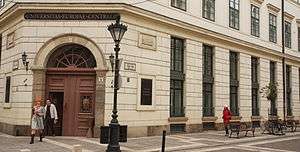
The Central European University (CEU) is a graduate-level, English-language university promoting a distinctively Central European perspective. It was established in 1991 by the Hungarian philanthropist George Soros, who has provided an endowment of US$880 million, making the university one of the wealthiest in Europe.[130] In the academic year 2013/2014, the CEU had 1,381 students from 93 countries and 388 faculty members from 58 countries.[131]
Culture and society
Research centres of Central European literature include Harvard (Cambridge, MA),[132] and Purdue University.[133]
Architecture
Religion
Central European countries are mostly Catholic (Austria, Croatia, Hungary, Liechtenstein, Luxembourg, Poland, Slovakia, Slovenia) or mixed Catholic and Protestant, (Germany and Switzerland). Large Protestant groups include Lutheran and Calvinist. Significant populations of Eastern Catholicism and Old Catholicism are also prevalent throughout Central Europe. Central Europe has been a centre of Protestantism in the past; however, it has been mostly eradicated by the Counterreformation.[134][135][136] The Czech Republic (Bohemia) was historically the first Protestant country, then violently recatholised, and now overwhelmingly non-religious, nevertheless the largest number of religious people are Catholic (10.3%). Romania and Serbia are mostly Eastern Orthodox with significant Protestant and Catholic minorities.
Before the Holocaust (1941–45), there was also a sizeable Ashkenazi Jewish community in the region, numbering approximately 16.7 million people.[137]
In some of these countries, there is a number of atheists, undeclared and non-religious people: the Czech Republic (non-religious 34.2% and undeclared 45.2%), Germany (non-religious 38%), Slovenia (atheist 14.7%[138]), Luxembourg (23.4 non-religious[138]), Switzerland (20.1%), Hungary (27.2% undeclared, 16.7% "non-religious" and 1.5% atheists), Slovakia (atheists and non-religious 13.4%, "not specified" 10.6%) Austria (19.7% of "other or none"), Liechtenstein (10.6% with no religion), Croatia (4%) and Poland (3% of non-believers/agnostics and 1% of undeclared).
Central Europe church buildings gallery
 St. Vitus Cathedral, Prague (Catholic), Czech Republic
St. Vitus Cathedral, Prague (Catholic), Czech Republic Zagreb Cathedral, Zagreb (Catholic), Croatia
Zagreb Cathedral, Zagreb (Catholic), Croatia Wrocław Cathedral (Catholic), Poland
Wrocław Cathedral (Catholic), Poland St. Mary's Basilica in Kraków (Catholic), Poland
St. Mary's Basilica in Kraków (Catholic), Poland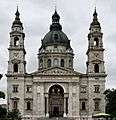 St. Stephen's Basilica in Budapest (Catholic), Hungary
St. Stephen's Basilica in Budapest (Catholic), Hungary Jesuit Church, Lucerne (Catholic), Switzerland
Jesuit Church, Lucerne (Catholic), Switzerland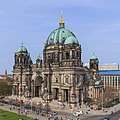 Berlin Cathedral (United Protestant - Lutheran & Calvinist), Germany
Berlin Cathedral (United Protestant - Lutheran & Calvinist), Germany- Grossmünster (Calvinist), Switzerland
 Reformed Great Church of Debrecen (Calvinist), Hungary
Reformed Great Church of Debrecen (Calvinist), Hungary Abbey of Saint Gall (Catholic), Switzerland
Abbey of Saint Gall (Catholic), Switzerland- Cologne Cathedral (Catholic), Germany
 Matthias Church is a Catholic church in Budapest, Hungary
Matthias Church is a Catholic church in Budapest, Hungary Cathedral of St. Peter and Paul in Brno (Catholic), Czech Republic
Cathedral of St. Peter and Paul in Brno (Catholic), Czech Republic Vaduz Cathedral (Catholic), Liechtenstein
Vaduz Cathedral (Catholic), Liechtenstein- St. Stephen's Cathedral in Vienna (Catholic), Austria
- St. Elisabeth Cathedral in Košice (Catholic), Slovakia
- St. Theresa of Avila Cathedral, Subotica, Serbia (Catholic)
- Evangelical church in Partizánska Ľupča (Lutheran), Slovakia
- Esztergom Basilica (Catholic), is an ecclesiastic basilica in Esztergom, Hungary

 Vršac Cathedral, Vršac (Catholic), Serbia
Vršac Cathedral, Vršac (Catholic), Serbia
Cuisine
Central European cuisine has evolved through centuries due to social and political change. Most countries share many dishes. The most popular dishes typical to Central Europe are sausages and cheeses, where the earliest evidence of cheesemaking in the archaeological record dates back to 5,500 BCE (Kujawy, Poland).[139] Other foods widely associated with Central Europe are goulash and beer. List of countries by beer consumption per capita is led by the Czech Republic, followed by Germany and Austria. Poland comes 5th, Croatia 7th and Slovenia 13th.
Human rights
History
Human rights have a long tradition in Central Europe. In 1222 Hungary defined for the first time the rights of the nobility in its "Golden Bull". In 1264 the Statute of Kalisz and the General Charter of Jewish Liberties introduced numerous rights for the Jews in Poland, granting them de facto autonomy. In 1783 for the first time, Poland forbid corporal punishment of children in schools. In the same year, a German state of Baden banned slavery.
On the other hand, there were also major regressions, such as "Nihil novi" in Poland in 1505 which forbade peasants from leaving their land without permission from their feudal lord.
Present
Generally, the countries in the region are progressive on the issue of human rights: death penalty is illegal in all of them, corporal punishment is outlawed in most of them and people of both genders can vote in elections. Nevertheless, Central European countries struggle to adopt new generations of human rights, such as same-sex marriage. Austria, the Czech Republic, Germany, and Poland also have a history of participation in the CIA's extraordinary rendition and detention program, according to the Open Society Foundation.[140][141]
Literature
Regional writing tradition revolves around the turbulent history of the region, as well as its cultural diversity.[142][143] Its existence is sometimes challenged.[144] Specific courses on Central European literature are taught at Stanford University,[145] Harvard University[146] and Jagiellonian University[147] The as well as cultural magazines dedicated to regional literature.[148] Angelus Central European Literature Award is an award worth 150,000.00 PLN (about $50,000 or £30,000) for writers originating from the region.[149] Likewise, the Vilenica International Literary Prize is awarded to a Central European author for "outstanding achievements in the field of literature and essay writing."[150]
Media
Sport
There is a number of Central European Sport events and leagues. They include:
- Central European Tour Miskolc GP (Hungary)*
- Central European Tour Budapest GP (Hungary)
- Central Europe Rally (Romania and Hungary)*
- Central European Football League (Austria, Croatia, Hungary, Serbia, Slovakia, Slovenia and Turkey)
- Central European International Cup (Austria, Czechoslovakia, Hungary, Italy, Poland, Switzerland and Yugoslavia; 1927–1960)
- Central Europe Throwdown*[151]
Football is one of the most popular sports. Countries of Central Europe had many great national teams throughout history and hosted several major competitions. Yugoslavia hosted UEFA Euro 1976 before the competition expanded to 8 teams and Germany (at that times as West Germany) hosted UEFA Euro 1988. Recently, 2008 and 2012 UEFA European Championships were held in Austria & Switzerland and Poland & Ukraine respectively. Germany hosted 2 FIFA World Cups (1974 and 2006) and are the current champions (as of 2014).[152][153][154]
Politics
Organisations
Central Europe is a birthplace of regional political organisations:
- Visegrád Group
- Centrope
- Central European Initiative
- Central European Free Trade Agreement
- Middleeuropean Initiative
- Central European Defence Cooperation
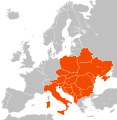 Central European Initiative
Central European Initiative Central European Defence Cooperation
Central European Defence Cooperation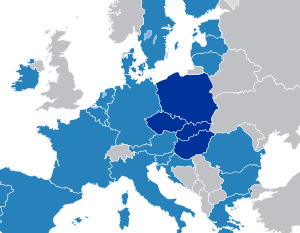 Visegrád Group
Visegrád Group- CEFTA founding states
- CEFTA members in 2003, before joining the EU
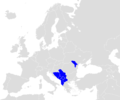 Current CEFTA members
Current CEFTA members
Democracy Index
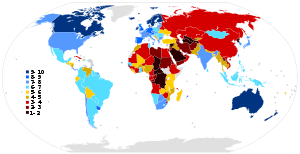
Central Europe is a home to some of world's oldest democracies. However, most of them have been impacted by totalitarianism, particularly Fascism and Nazism. Germany and Italy occupied all Central European countries, except Switzerland. In all occupied countries, the Axis powers suspended democracy and installed puppet regimes loyal to the occupation forces. Also, they forced conquered countries to aplly racial laws and formed military forces for helping German and Italian struggle against Communists. After World War II, almost the whole of Central Europe (the Eastern and Middle part) was occupied by Communists. Communism also banned democracy and free elections, and human rights did not exist in Communist countries. Most of Central Europe had been occupied and later allied with the Soviet Union, often against their will through forged referendum (e.g., Polish people's referendum in 1946) or force (northeast Germany, Poland, Hungary et alia). Nevertheless, these experiences have been dealt in most of them. Most of Central European countries score very highly in the Democracy Index.[155]
Global Peace Index

In spite of its turbulent history, Central Europe is currently one of world's safest regions. Most Central European countries are in top 20%.[156]
Central European Time
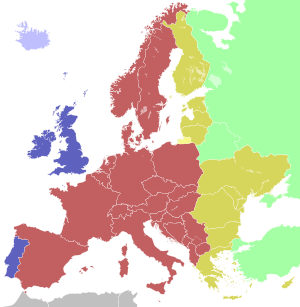
The time zone used in most parts of the European Union is a standard time which is 1 hour ahead of Coordinated Universal Time. It is commonly called Central European Time because it has been first adopted in central Europe (by year):
In popular culture
Central Europe is mentioned in 35th episode of Lovejoy, entitled "The Prague Sun", filmed in 1992. While walking over the famous Charles Bridge, the main character, Lovejoy says: " I've never been to Prague before. Well, it is one of the great unspoiled cities in Central Europe. Notice: I said: "Central", not "Eastern"! The Czechs are a bit funny about that, they think of Eastern Europeans as turnip heads."[159]
Wes Anderson's Oscar-winning film The Grand Budapest Hotel is regarded as a fictionalised celebration of the 1930s in Central Europe, and the region's musical tastes.[160][161]
See also
- Geographical midpoint of Europe
- Central and Eastern Europe
- Central European Initiative
- Central European Time (CET)
- Central European University
- East-Central Europe
- Eurovoc
- Life zones of central Europe
- Międzymorze (Intermarum)
- Mitteleuropa
References
- "The World Factbook: Field listing – Location". The World Factbook. Central Intelligence Agency. 2009. Archived from the original on 24 May 2011. Retrieved 3 May 2009.
- Jordan, Peter (2005). "Großgliederung Europas nach kulturräumlichen Kriterien" [The large-scale division of Europe according to cultural-spatial criteria]. Europa Regional. Leipzig: Leibniz-Institut für Länderkunde (IfL). 13 (4): 162–173. Retrieved 21 January 2019 – via Ständiger Ausschuss für geographische Namen (StAGN).
- "Regions, Regionalism, Eastern Europe by Steven Cassedy". New Dictionary of the History of Ideas, Charles Scribner's Sons. 2005. Retrieved 31 January 2010.
- Lecture 14: The Origins of the Cold War. Historyguide.org. Retrieved on 29 October 2011.
- "Central Europe –The future of the Visegrad group". The Economist. 14 April 2005. Retrieved 7 March 2009.
- Ágh 1998, p. 2–8.
- "Central European Identity in Politics – Jiří Pehe" (in Czech). Conference on Central European Identity, Central European Foundation, Bratislava. 2002. Retrieved 31 January 2010.
- "Europe of Cultures: Cultural Identity of Central Europe". Europe House Zagreb, Culturelink Network/IRMO. 24 November 1996. Retrieved 31 January 2010.
- Comparative Central European culture. Purdue University Press. 2002. ISBN 978-1-55753-240-4. Retrieved 31 January 2010.
- "An Introduction to Central Europe: History, Culture, and Politics – Preparatory Course for Study Abroad Undergraduate Students at CEU" (PDF). Central European University. Budapest. Fall 2006. Archived from the original (PDF) on 17 June 2010.
- Ben Koschalka – content, Monika Lasota – design and coding. "To Be (or Not To Be) Central European: 20th Century Central and Eastern European Literature". Centre for European Studies of the Jagiellonian University. Archived from the original on 3 March 2001. Retrieved 31 January 2010.
- "Ten Untaught Lessons about Central Europe-Charles Ingrao". Habs burg Occasional Papers, No. 1. 1996. Archived from the original on 14 December 2003. Retrieved 31 January 2010.
- "Introduction to the electronic version of Cross Currents". Scholarly Publishing Office of the University of Michigan Library. Retrieved 31 January 2010.
- Cornis-Pope, Marcel; Neubauer, John (2004). History of the literary cultures of East–Central Europe: junctures and disjunctures in the 19th and 20th centuries, Volume 2. ISBN 9027234531.
- "When identity becomes an alibi (Institut Ramon Llull)" (PDF).
- "The Mice that Roared: Central Europe Is Reshaping Global Politics". Spiegel.de. 26 February 2006. Retrieved 31 January 2010.
- "Which regions are covered?". European Regional Development Fund. Archived from the original on 3 April 2010. Retrieved 31 January 2010.
- 2010 Human Development Index. (PDF) . Retrieved on 29 October 2011.
- Magocsi 2002, chapter 11.
- Kasper von Greyerz (2007). Religion and Culture in Early Modern Europe. Oxford University Press. pp. 38–. ISBN 978-0-19-804384-3.
- Jean W Sedlar (1994). East Central Europe in the Middle Ages, 1000–1500. University of Washington Press. pp. 161–. ISBN 0-295-97291-2.
- Dumitran, Adriana (2010). "Uspořádání Evropy – duch kulturní jednoty na prahu vzniku novověké Evropy" [The shape of Europe. The spirit of unity through culture in the eve of Modern Europe] (in Czech). Czech Republic: Bibliography of the History of the Czech Lands, The Institute of History, Academy of Sciences of the Czech Republic.
- László Zsinka. "Similarities and Differences in Polish and Hungarian History" (PDF). Retrieved 15 January 2015.
- Halman, Loek; Wilhelmus Antonius Arts (2004). European values at the turn of the millennium. Brill Publishers. p. 120. ISBN 978-90-04-13981-7.
- Source: Geographisches Handbuch zu Andrees Handatlas, vierte Auflage, Bielefeld und Leipzig, Velhagen und Klasing, 1902.
- Jackson J. Spielvogel: Western Civilization: Alternate Volume: Since 1300. p. 618.
- ""Mitteleuropa" is a multi-facetted concept and difficult to handle" (PDF). Archived from the original (PDF) on 17 December 2008. Retrieved 31 January 2010.
- A. Podraza, Europa Środkowa jako region historyczny, 17th Congress of Polish Historians, Jagiellonian University 2004
- Joseph Franz Maria Partsch, Clementina Black, Halford John Mackinder, Central Europe, New York 1903
- F. Naumann, Mitteleuropa, Berlin: Reimer, 1915
- "Regions and Eastern Europe Regionalism – Central Versus Eastern Europe". Science.jrank.org. Retrieved 31 January 2010.
- "Between Worlds – The MIT Press". Mitpress.mit.edu. Archived from the original on 22 September 2006. Retrieved 31 January 2010.
- , and ; Géographie universelle (1927), edited by Paul Vidal de la Blache and Lucien Gallois
- Deak, I. (2006). "The Versailles System and Central Europe". The English Historical Review. CXXI (490): 338. doi:10.1093/ehr/cej100.
- Johnson 1996, p. 165.
- Hayes 1994, p. 16.
- Hayes 1994, p. 17.
- Johnson 1996, p. 6.
- Johnson 1996, p. 7.
- Johnson 1996, p. 7, 165, 170.
- Gerald Stourzh "Geschichte des Staatsvertrages 1945-1955" ((1980), p 4.
- Wolfgang Mueller "Die sowjetische Besatzung in Österreich 1945-1955 und ihre politische Mission" (German - "The Soviet occupation in Austria 1945-1955 and its political mission"), 2005, p 24.
- Sinnhuber, Karl A. (1 January 1954). "Central Europe: Mitteleuropa: Europe Centrale: An Analysis of a Geographical Term". Transactions and Papers (Institute of British Geographers) (20): 15–39. doi:10.2307/621131. JSTOR 621131.
- "Kundera's article in PDF format" (PDF).
- "Central versus Eastern Europe".
- One of the main representatives was Oscar Halecki and his book The limits and divisions of European history, London and New York 1950
- A. Podraza, Europa Środkowa jako region historyczny, 17th Congress of Polish Historians, Jagiellonian University 2004
- Tiersky 2004, p. 472.
- Katzenstein 1997, p. 6.
- Katzenstein 1997, p. 4.
- Jerzy Kłoczowski, Actualité des grandes traditions de la cohabitation et du dialogue des cultures en Europe du Centre-Est, in: L'héritage historique de la Res Publica de Plusieurs Nations, Lublin 2004, pp. 29–30 ISBN 83-85854-82-7
- Oskar Halecki, The Limits and Divisions of European History, Sheed & Ward: London and New York 1950, chapter VII
- Johnson 1996, p. ?.
- Johnson 1996, p. 4.
- Legvold, Robert (May–June 1997). "Central Europe: Enemies, Neighbors, Friends". Foreign Affairs. Council on Foreign Relations. Retrieved 20 May 2009.
- "Selected as "Editor's Choice" of the History Book Club". Oxford University Press. Retrieved 20 May 2009.
- Bucur, Maria (June 1997). "The Myths and Memories We Teach By". Indiana University. HABSBURG. Retrieved 23 December 2011.
- "Europe". Columbia Encyclopedia. Columbia University Press. 2009.
- "Slovenia". Encarta. Archived from the original on 28 October 2009. Retrieved 1 May 2009.
- Band 16, Bibliographisches Institut Mannheim/Wien/Zürich, Lexikon Verlag 1980
- Magocsi 2002, p. 20.
- Zepetnek 2011, p. 24.
- Vértesy, László (2018). "Macroeconomic Legal Trends in the EU11 Countries" (PDF). Public Governance, Administration and Finances Law Review. 3. No. 1. 2018. Archived from the original (PDF) on 12 August 2019. Retrieved 12 August 2019.
- "From Visegrad to Mitteleuropa". The Economist. 14 April 2005.
- Johnson, pp. 16
- Robert Bideleux; Ian Jeffries (10 April 2006). A History of Eastern Europe: Crisis and Change. Routledge. p. 12. ISBN 978-1-134-71984-6. Retrieved 16 October 2015.
- Erich Schenk, Mitteleuropa. Düsseldorf, 1950
- "For the Record". The Washington Post. 3 May 1990. Archived from the original on 24 June 2011. Retrieved 31 January 2010 – via Highbeam.com.
- "United Nations Statistics Division – Standard Country and Area Codes Classifications (M49)". Unstats.un.org. 31 October 2013. Retrieved 4 August 2014.
- "World Population Ageing: 1950–2050" (PDF). United Nations. Retrieved 15 January 2015.
- "Browse MT 7206". Eurovoc.europa.eu. Retrieved 4 August 2014.
- Webra International Kft. (18 March 1999). "The Puzzle of Central Europe". Visegradgroup.eu. Retrieved 4 August 2014.
- "Highlights of Eastern Europe (Vienna through Slovenia, Croatia, Hungary, Slovakia, Poland, Germany and the Czech Republic)". a-ztours.com. Archived from the original on 20 October 2014. Retrieved 15 January 2015.
- "Mastication Monologues: Western Europe". masticationmonologues.com. Retrieved 15 January 2015.
- "In the Heavy Shadow of the Ukraine/Russia Crisis, page 10" (PDF). European Bank for Reconstruction and Development. September 2014. Retrieved 15 January 2015.
- "UNHCR in Central Europe". UNCHR. Archived from the original on 26 August 2013.
- "Central European Green Corridors – Fast charging cross-border infrastructure for electric vehicles, connecting Austria, Slovakia, Slovenia, Germany and Croatia" (PDF). Central European Green Corridors. October 2014. Archived from the original (PDF) on 2 April 2015.
- "Interreg Central Europe Homepage". central2020.eu.
- Andrew Geddes, Charles Lees, Andrew Taylor : "The European Union and South East Europe: The Dynamics of Europeanization and multilevel governance", 2013, Routledge
- Klaus Liebscher, Josef Christl, Peter Mooslechner, Doris Ritzberger-Grünwald : "European Economic Integration and South-East Europe: Challenges and Prospects", 2005, Edward Elgar Publishing Limited
- Sven Tägil, Regions in Central Europe: The Legacy of History, C. Hurst & Co. Publishers, 1999, p. 191
- Klaus Peter Berger, The Creeping Codification of the New Lex Mercatoria, Kluwer Law International, 2010, p. 132
- Alan Rogers Central Europe 2007 – Quality Camping & Caravanning Sites. Alan Rogers Guides, Ltd. 2007. p. 78. ISBN 9780955048685.
- United States. Foreign Broadcast Information Service Daily report: East Europe
- Council of Europe. Parliamentary Assembly. Official Report of Debates. Council of Europe. 1994. p. 1579. ISBN 978-92-871-2516-3. Retrieved 16 October 2015.
- "About Serbia". UNDP in Serbia. United Nations Development Programme. 2018.
- Irena Kogan: Delayed Transition: Education and Labor Market in Serbia , Making the Transition: Education and Labor Market Entry in Central and Eastern Europe, 2011, chapter 6
- Shadbolt, Peter (11 December 2014). "Serbia: the country at the crossroads of Europe". CNN.
- WMO, UNCCD, FAO, UNW-DPC , Country Report: Drought conditions and management strategies in Serbia, 2013, p. 1
- Zepetnek 2011, p. ?.
- Government of Hungary, Prime Minister Viktor Orbán’s speech at the Energy Forum following a joint meeting of the Serbian and Hungarian cabinets , Government of Hungary on Serbia, 2018
- Armstrong, Werwick. Anderson, James (2007). "Borders in Central Europe: From Conflict to Cooperation". Geopolitics of European Union Enlargement: The Fortress Empire. Routledge. p. 165. ISBN 978-1-134-30132-4.CS1 maint: uses authors parameter (link)
- "Map of Europe". TheFreeDictionary.com. Retrieved 15 January 2015.
- Transcarpathia: Perephiral Region at the "Centre of Europe" (Google eBook). Region State and Identity in Central and Eastern Europe. Routledge. 2013. p. 155. ISBN 978-1-136-34323-0.
- Bokros, Lajos (15 January 2013). Accidental Occidental: Economics and Culture of Transition in Mitteleuropa, the Baltic and the Balkan Area. Central European University Press. ISBN 9786155225246 – via Google Books.
- Danube Facts and Figures. Bosnia and Herzegovina (April 2007) (PDF file)
- Encyclopædia Britannica. "Dinaric Alps (mountains, Europe)". Retrieved 31 January 2010.
- Juliane Dittrich. "Die Alpen – Höhenstufen und Vegetation – Hauptseminararbeit". GRIN. Retrieved 31 January 2010.
- Wolfgang Frey and Rainer Lösch; Lehrbuch der Geobotanik. Pflanze und Vegetation in Raum und Zeit. Elsevier, Spektrum Akademischer Verlag, München 2004 ISBN 3-8274-1193-9
- "Demography report 2010" (PDF). Eurostat. Archived from the original (PDF) on 27 February 2012. Retrieved 12 May 2012.
- "Główny Urząd Statystyczny / Spisy Powszechne / NSP 2011 / Wyniki spisu NSP 2011". 14 July 2014. Archived from the original on 14 July 2014.
- "Czech Republic: The Final Census Results to be Released in the Third Quarter of 2012" (PDF). Czech Statistical Office. 7 May 2012. Archived from the original (PDF) on 3 March 2016. Retrieved 15 October 2015.
- "Sajtótájékoztató 2013" [Press Conference 2013] (PDF) (Press release) (in Hungarian). Hungarian Central Statistical Office. 28 March 2013. Retrieved 15 October 2015.
- "Swiss Statistics – Overview". Bfs.admin.ch. 27 August 2015. Archived from the original on 28 June 2016. Retrieved 24 September 2015.
- "Development in the number of inhabitants – 2011, 2001, 1991, 1980, 1970" (PDF). Statistical Office of the Slovak Republic. 2012. Archived from the original (PDF) on 14 November 2012.
- "Landesverwaltung Liechtenstein". Llv.li. Retrieved 24 September 2015.
- "Central Bureau of Statistics". Dzs.hr. Retrieved 27 September 2015.
- "Statistical Office of the Republic of Slovenia - Population, Slovenia, 1 January 2014 – final data". 2 May 2014. Archived from the original on 2 May 2014.CS1 maint: BOT: original-url status unknown (link)
- "ПОЧЕТНА | Републички завод за статистику Србије". www.stat.gov.rs. Retrieved 13 February 2019.
- "Total population, Candidate countries and potential candidates". Eurostat.
- "2018 KOF Globalization Index" (PDF). KOF Index of Globalization. 2018. Retrieved 5 August 2019.
- "Rankings". Legatum Prosperity Index 2018. Retrieved 25 July 2019.
- e.V, Transparency International. "Corruption Perceptions Index 2018". www.transparency.org. Retrieved 25 July 2019.
- Magocsi 2002, p. 1758.
- Magocsi 2002, p. ?.
- "Launch of railway projects puts Serbia among EU member states". Railway Pro. 27 February 2013. Retrieved 4 August 2014.
- "Response to questionnaire for: Assessment of strategic plans and policy measures on Investment and Maintenance in Transport Infrastructure Country: Serbia" (PDF). internationaltransportforum.org. Archived from the original (PDF) on 24 September 2015. Retrieved 15 October 2015.
- "Inland transport infrastructure at regional level – Statistics Explained". Epp.eurostat.ec.europa.eu. Archived from the original on 8 May 2013. Retrieved 4 August 2014.
- "Statistical Database – United Nations Economic Commission for Europe". W3.unece.org. 29 December 1980. Archived from the original on 22 October 2014. Retrieved 4 August 2014.
- "Spread of the Industrial Revolution". Srufaculty.sru.edu. 16 August 2001. Archived from the original on 23 January 2005. Retrieved 4 August 2014.
- Gnel Gabrielyan, Domestic and Export Price Formation of U.S. Hops Archived 26 April 2014 at the Wayback Machine School of Economic Sciences at Washington State University. PDF file, direct download 220 KB. Retrieved 25 April 2014.
- http://pod2.stat.gov.rs/ObjavljenePublikacije/G2012/pdf/G20122007.pdf
- "Serbia Overview". Food and Agriculture Organization of the United Nations. Retrieved 14 June 2013.
- "Welcome centraleurope.org – Hostmonster.com". www.centraleurope.org.
- "The Travel & Tourism Competitiveness Report 2011: Beyond the Downturn" (PDF). World Economic Forum. 2011. Retrieved 16 October 2015.
- Ewing, Jack (22 December 2013). "Midsize Cities in Poland Develop as Service Hubs for Outsourcing Industry". The New York Times. ISSN 0362-4331. Retrieved 6 October 2015.
- "2013 Top 100 Outsourcing Destinations: Rankings and Report Overview" (PDF). Tholons. January 2013. Archived from the original (PDF) on 4 March 2016. Retrieved 16 October 2015.
- "PISA 2012 Results in Focus: What 15-year-olds know and what they can do with what they know" (PDF). OECD. 2014. Retrieved 16 October 2015.
- Joachim W. Stieber: "Pope Eugenius IV, the Council of Basel and the secular and ecclesiastical authorities in the Empire: the conflict over supreme authority and power in the church", Studies in the history of Christian thought, Vol. 13, Brill, 1978, ISBN 90-04-05240-2, p.82; Gustav Stolper: "German Realities", Read Books, 2007, ISBN 1-4067-0839-9, p. 228; George Henry Danton: "Germany ten years after", Ayer Publishing, 1928, ISBN 0-8369-5693-1, p. 210; Vejas Gabriel Liulevicius: "The German Myth of the East: 1800 to the Present", Oxford Studies in Modern European History Series, Oxford University Press, 2009, ISBN 0-19-954631-2, p. 109; Levi Seeley: "History of Education", BiblioBazaar, ISBN 1-103-39196-8, p. 141
- Aisha Labi (2 May 2010). "For President of Central European University, All Roads Led to Budapest". The Chronicle of Higher Education. Retrieved 15 January 2015.
- "CEU Facts and Figures". Central European University. Retrieved 15 January 2015.
- Faculty of Arts and Sciences Harvard College. "Central European Studies". Static.fas.harvard.edu. Archived from the original on 4 March 2016. Retrieved 24 September 2015.
- "Project MUSE – Comparative Central European Culture". Muse.jhu.edu. Retrieved 24 September 2015.
- "pError". Go.hrw.com. Retrieved 27 September 2015.
- "Map: The Religious Divisions of Europe ca. 1555". Pearson. Retrieved 16 October 2015.
- "Map of Europe in 1560: Religion". Emersonkent.com. Retrieved 24 September 2015.
- "The Jewish Population of the World (2010)". Jewish Virtual Library., based on American Jewish Year Book. American Jewish Committee.
- "Eurobarometer 90.4 (December 2018): Attitudes of Europeans towards Biodiversity, Awareness and Perceptions of EU customs, and Perceptions of Antisemitism", Special Eurobarometer, European Union: European Commission, 2019, retrieved 9 August 2019 – via GESIS
- "Art of cheese-making is 7,500 years old". Nature News & Comment.
- "CIA Secret Detention and Torture". Open Society Foundations. Archived from the original on 25 September 2015. Retrieved 24 September 2015.
- "TRANSCEND MEDIA SERVICE". Retrieved 24 September 2015.
- "In praise of writers' bloc: How the tedium of life under Communism gave rise to a literature alive with surrealism and comedy". The Independent. Retrieved 24 September 2015.
- "Comparative Central European Culture". Thepress.purdue.edu. Retrieved 24 September 2015.
- "Czech mates". Newstatesman.com. Retrieved 24 September 2015.
- Archived 23 February 2015 at the Wayback Machine
- "Secondary Fields". Slavic.fas.harvard.edu. Retrieved 24 September 2015.
- "Literatura Środkowoeuropejska w poszukiwaniu tożsamości". Usosweb.uj.edu.pl. Retrieved 24 September 2015.
- "literalab". Retrieved 24 September 2015.
- "Regulations". Angelus.com.pl. Retrieved 24 September 2015.
- "About Vilenica". Vilenica Literary Festival. Retrieved 14 February 2018.
- "Central Europe Throwdown 2015". Retrieved 24 September 2015.
- "2018 FIFA World Cup Russia - Qualifiers". FIFA.com. Retrieved 24 September 2015.
- "Germany are FIFA World Cup Champions!". NDTVSports.com. Retrieved 24 September 2015.
- James Richardson. "World Cup Football Daily: Germany crowned champions of the world". the Guardian. Retrieved 24 September 2015.
- "Democracy index 2012: Democracy at a standstill: A report from The Economist Intelligence Unit". The Economist. 2013. Archived from the original (PDF) on 3 January 2015. Retrieved 15 October 2015.
- "Vision of Humanity".
- Since Poland was partitioned since 1922 (official adoption), the dates of introduction in Germany (1893) and Austria (1893) should be understood as de facto adoption
- "Time Zone & Clock Changes in Belgrade, Serbia". www.timeanddate.com. Retrieved 19 July 2018.
- "Lovejoy – Season 3, Episode 13: The Prague Sun – TV.com". TV.com. Retrieved 26 November 2014.
- Richard Brody (7 March 2014). ""The Grand Budapest Hotel": Wes Anderson's Artistic Manifesto". The New Yorker. Retrieved 24 September 2015.
- Los Angeles Times (22 February 2015). "Oscars 2015 live updates: J.K. Simmons, 'Grand Budapest Hotel' win first awards – LA Times". latimes.com. Retrieved 24 September 2015.
Bibliography
- Ádám, Magda (2003). The Versailles System and Central Europe Variorum Collected Studies. Ashgate. ISBN 0-86078-905-5.CS1 maint: ref=harv (link)
- Ádám, Magda (1993). The Little Entente and Europe(1920–1929). Akadémiai Kiadó. ISBN 963-05-6420-3.CS1 maint: ref=harv (link)
- Ágh, Attila (1998). The politics of Central Europe. Sage. ISBN 0-7619-5032-X.CS1 maint: ref=harv (link)
- Hayes, Bascom Barry (1994). Bismarck and Mitteleuropa. Fairleigh Dickinson University Press. ISBN 978-0-8386-3512-4.CS1 maint: ref=harv (link)
- Johnson, Lonnie R. (1996). Central Europe: enemies, neighbors, friends. Oxford University Press. ISBN 978-0-19-510071-6.CS1 maint: ref=harv (link)
- Katzenstein, Peter J. (1997). Mitteleuropa: Between Europe and Germany. Berghahn Books. ISBN 978-1-57181-124-0.CS1 maint: ref=harv (link)
- Magocsi, Paul Robert (2002). Historical Atlas of Central Europe (Rev. and expanded ed.). University of Toronto Press. ISBN 978-0-8020-8486-6. OCLC 150672781.CS1 maint: ref=harv (link)
- O. Benson, Forgacs (2002). Between Worlds. A Sourcebook of Central European Avant-Gardes, 1910–1930. MIT Press. ISBN 978-0-262-02530-0.CS1 maint: ref=harv (link)
- Tiersky, Ronald (2004). Europe today. Rowman & Littlefield. ISBN 978-0-7425-2805-5.CS1 maint: ref=harv (link)
- Tötösy de Zepetnek, Steven; Vasvári, Louise Olga (2011). Comparative Hungarian Cultural Studies. Comparative cultural studies. West Lafayette, Indiana: Purdue University Press. ISBN 978-1-55753-593-1. OCLC 1088215162. Retrieved 24 November 2014.
- Shared Pasts in Central and Southeast Europe, 17th–21st Centuries. Eds. G. Demeter, P. Peykovska. 2015
Further reading
- Donert, Celia, Emily Greble, and Jessica Wardhaugh. "New Scholarship on Central and Eastern Europe." Contemporary European History 26.3 (2017): 507-507. DOI: https://doi.org/10.1017/S0960777317000224
- Jacques Rupnik, "In Search of Central Europe: Ten Years Later", in Gardner, Hall, with Schaeffer, Elinore & Kobtzeff, Oleg, (ed.), Central and South-central Europe in Transition, Westport, Connecticut: Praeger, 2000 (translated from French by Oleg Kobtzeff)
- Article 'Mapping Central Europe' in hidden europe, 5, pp. 14–15 (November 2005)
- Journal of East Central Europe
- Central European Political Science Association's journal "Politics in Central Europe"
- CEU Political Science Journal (PSJ)
- Central European Journal of International and Security Studies
- Central European Political Studies Review
External links
| Wikimedia Commons has media related to Central Europe. |
| Wikiquote has quotations related to: East/Central Europe |
| Wikivoyage has a travel guide for Central Europe. |

- Halecki, Oscar. "BORDERLANDS OF WESTERN CIVILIZATION A History of East Central Europe" (PDF). Oscar Halecki. Archived from the original (PDF) on 30 October 2010. Retrieved 8 August 2010.
- The Centrope region
- Maps of Europe and European countries
- CENTRAL EUROPE 2020
- Central Europe Economy
- UNHCR Office for Central Europe
